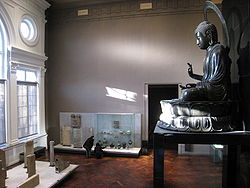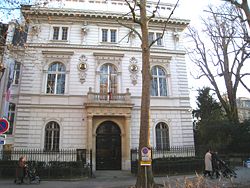
Musée Cernuschi
Encyclopedia


Asian art
Asian art can refer to art amongst many cultures in Asia.-Various types of Asian art:*Afghan art*Azerbaijanian art*Balinese art*Bhutanese art*Buddhist art*Burmese contemporary art*Chinese art*Eastern art*Indian art*Iranian art*Islamic art...
museum
Museum
A museum is an institution that cares for a collection of artifacts and other objects of scientific, artistic, cultural, or historical importance and makes them available for public viewing through exhibits that may be permanent or temporary. Most large museums are located in major cities...
located at 7 avenue Vélasquez, near Parc Monceau
Parc Monceau
Parc Monceau is a semi-public park situated in the 8th arrondissement of Paris, France, at the junction of Boulevard de Courcelles, Rue de Prony and Rue Georges Berger. At the main entrance is a rotunda. The park covers an area of 8.2 hectares ....
, in Paris
Paris
Paris is the capital and largest city in France, situated on the river Seine, in northern France, at the heart of the Île-de-France region...
, France
France
The French Republic , The French Republic , The French Republic , (commonly known as France , is a unitary semi-presidential republic in Western Europe with several overseas territories and islands located on other continents and in the Indian, Pacific, and Atlantic oceans. Metropolitan France...
, specialising in China, Japan and Korea. Its collection in Asian art is second only to the Musée Guimet in Paris.
The museum was founded in 1898 by Henri Cernuschi
Henri Cernuschi
Henri Cernuschi , was a major French banker, economist and Asian art collector, who started off as an Italian politician in 1848-1850....
(1821-1896) and is located in the small mansion which used to be his home. It describes itself as the second-oldest Asian art
Asian art
Asian art can refer to art amongst many cultures in Asia.-Various types of Asian art:*Afghan art*Azerbaijanian art*Balinese art*Bhutanese art*Buddhist art*Burmese contemporary art*Chinese art*Eastern art*Indian art*Iranian art*Islamic art...
museum in France, and the fifth-oldest Chinese art
Chinese art
Chinese art is visual art that, whether ancient or modern, originated in or is practiced in China or by Chinese artists or performers. Early so-called "stone age art" dates back to 10,000 BC, mostly consisting of simple pottery and sculptures. This early period was followed by a series of art...
museum in Europe. Over the years, its collection has gradually grown from some 5,000 objects to its current total of about 12,500 objects of art and archaeology. After the renovations which closed the Museum from 2001 to 2005, total exhibit space is now about 3,200 m².
Some 900 objects are on permanent exhibit. Most prominent is the large Buddha
Buddharupa
Buddharūpa is the Sanskrit and Pali term used in Buddhism for statues or models of the Buddha.-Commonalities:...
of Meguro
Meguro, Tokyo
is one of the 23 special wards of Tokyo, Japan. It calls itself Meguro City in English.Meguro hosts fifteen foreign embassies and consulates. One of Tokyo's most exclusive residential neighborhoods is located in Meguro....
, a Japan
Japan
Japan is an island nation in East Asia. Located in the Pacific Ocean, it lies to the east of the Sea of Japan, China, North Korea, South Korea and Russia, stretching from the Sea of Okhotsk in the north to the East China Sea and Taiwan in the south...
ese bronze from the 18th century, collected by Cernuschi. Other permanent exhibits include:
- a fine collection of archaic bronze pieces (15th to 3rd centuries BC)
- Han DynastyHan DynastyThe Han Dynasty was the second imperial dynasty of China, preceded by the Qin Dynasty and succeeded by the Three Kingdoms . It was founded by the rebel leader Liu Bang, known posthumously as Emperor Gaozu of Han. It was briefly interrupted by the Xin Dynasty of the former regent Wang Mang...
objects (206 BC - 220 AD) - Funerary statues from the Northern WeiNorthern WeiThe Northern Wei Dynasty , also known as the Tuoba Wei , Later Wei , or Yuan Wei , was a dynasty which ruled northern China from 386 to 534 . It has been described as "part of an era of political turbulence and intense social and cultural change"...
Dynasty (386-534) and Sui DynastySui DynastyThe Sui Dynasty was a powerful, but short-lived Imperial Chinese dynasty. Preceded by the Southern and Northern Dynasties, it ended nearly four centuries of division between rival regimes. It was followed by the Tang Dynasty....
(581-618) - Tang DynastyTang DynastyThe Tang Dynasty was an imperial dynasty of China preceded by the Sui Dynasty and followed by the Five Dynasties and Ten Kingdoms Period. It was founded by the Li family, who seized power during the decline and collapse of the Sui Empire...
statues (618 - 907) - Ceramics from the TangTang DynastyThe Tang Dynasty was an imperial dynasty of China preceded by the Sui Dynasty and followed by the Five Dynasties and Ten Kingdoms Period. It was founded by the Li family, who seized power during the decline and collapse of the Sui Empire...
and SongSong DynastyThe Song Dynasty was a ruling dynasty in China between 960 and 1279; it succeeded the Five Dynasties and Ten Kingdoms Period, and was followed by the Yuan Dynasty. It was the first government in world history to issue banknotes or paper money, and the first Chinese government to establish a...
dynasties (6th through 13th centuries) - funerary masks in gilded bronze dating from the Liao DynastyLiao DynastyThe Liao Dynasty , also known as the Khitan Empire was an empire in East Asia that ruled over the regions of Manchuria, Mongolia, and parts of northern China proper between 9071125...
(907-1125)

